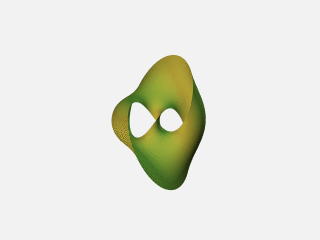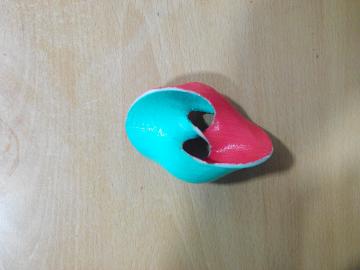Miguel A. Marco-Buzunariz

ORCID: 0000-0002-6750-8971
Researcher ID: ABG-1107-2020
Contact Information
PGP Key
Research Interests
Topology of algebraic varieties and their singularities. Hyperplane arrangements. Computational aspects of algebraic geometry.
Publications and Preprints
- E. Artal, J. Carmona, J.I. Cogolludo, and M.A. Marco Invariants of combinatorial line arrangements and Rybnikov's example, Proceedings of 12th MSJ-IRI symposium "Singularity theory and its applications", 2005. arXiv version.
- E. Artal, J. Carmona, J.I. Cogolludo, and M.A. Marco-Buzunariz, Topology and combinatorics of real line arrangements, Compositio Mathematica 141 (2005), no. 6, 1578-1588. arXiv version.
- M.A. Marco-Buzunariz, A description of the the resonance variety of a line arrangement via combinatorial pencils, Graphs and combinatorics 25 (2009), 469-488. arXiv version.
- M.A. Marco-Buzunariz, J. Martin Morales, Graded Betti numbers of the logarithmic derivation module, Communications in Algebra 38 (2010), no. 11, 4348-4361. arXiv version.
- M, A. Marco-Buzunariz, Isotropic subspaces of Orlik-Solomon algebras, Revista Matemática complutense, 24 (2011), 527-538. arXiv version
- M. A. Marco-Buzunariz, A polynomial generalization of the Euler characteristic for algebraic sets, Journal of Singularities 4 (2012), 114-130.
- J.I. Cogolludo, M.A. Marco-Buzunariz, The Max Noether fundamental theorem is combinatorial. arXiv version
- J. Fernandez de Bobadilla, M.A. Marco-Buzunariz, Topology of hypersurface singularities with 3-dimensional critical set, Comentarii Mathematici Helvetici, 88 (2013), no 2, 253-304. arXiv version
- M.A. Marco-Buzunariz, A framework for free, finitely presented and braid groups in SAGE. Monografías Matemáticas García de Galdeano 39 (2014), 167–176.
- Vincent Florens, Benoît Guerville-Ballé, Miguel A. Marco Buzunariz, On complex line arrangements and their boundary manifolds, Mathematical Proceedings of the Cambridge Philosophical Society 159 (2015), 189-205. arXiv version
- A. Abad, R. Barrio, M. Marco-Buzunariz and M. Rodríguez, Automatic implementation of the numerical Taylor series method: A Mathematica and Sage approach, Applied Mathematics and Computation, 268 (2015), 227-245
- E. Artal, J.I. Cogolludo-Agustín, B. Guerville-Ballé, M. Marco-Buzunáriz, An arithmetic Zariski pair of line arrangements with non-isomorphic fundamental group. Revista de la Real Academia de Ciencias Exactas, Físicas y Naturales. Serie A. Matemáticas (2016), 1-26. arXiv version
- M. Marco-Buzunariz, M. Rodriguez, SIROCCO: A Library for Certified Polynomial Root Continuation. Mathematical Software - ICMS 2016, Proceedings, 191-197. Lecture Notes in Computer Science. Springer.
- Pellicer-Ortín, Silvia; Arnal-Bailera, Alberto; Marco-Buzunariz, Miguel A.; Tomás-Aragonés, Lucía, The CLIL approach in higher education: a collaborative small-scale experience (with a focus on Mathematics and Psychology). Encuentro: revista de investigación e innovación en la clase de idiomas, 2016. 25, p. 87-101 . ISSN 1989-0796
- E.A. Bartolo, S.I. Peñaloza, M.Á. Marco-Buzunáriz, Heegaard splittings of graph manifolds. Annali di Matematica Pura ed Applicata (1923-) 198 (3) (2019), 727-747. arXiv version.
- M. Marco Buzunariz, Exact Computations with Approximate Methods. London Mathematical Society Newsletter 483 (2019), p. 31-35.
- J. Cuevas-Rozo, J. Divasón, M. Marco-Buzunáriz A.Romer, A Kenzo Interface for Algebraic Topology Computations in SageMath, ACM Communications in Computer Algebra 53, 2 (2019), 61-64. DOI: https://doi.org/10.1145/3371991.3371999
- M.Á. Marco Buzunáriz, M. Pe Pereira. Irreducibility of analytic arc-sections of hypersurface singularities. Periodica Mathematica Hungarica. DOI 0.1007/s10998-020-00346-x
- V. Manero, .Á. Marco Buzunáriz. Effective computation of degree bounded minimal models for GCDA's. Journal of Software for Algebra and Geometry, 10 (2020), 25-39.
- M.A. Marco-Buzunariz. Web Based Notebooks for Teaching, an Experience at Universidad de Zaragoza. Mathematical Software - ICMS 2020, Proceedings, 386-392. Lecture Notes in Computer Science. Springer.
- M. Avendaño, M.A. Marco-Buzunariz. A structural attack to the DME-(3,2,q) cryptosystem. Finite Fields and Their Applications, 71 (2021).
- A. Garvin, R. Gonzalez-Diaz, M.A. Marco Buzunariz, B. Medrano. Making Sullivan Algebras Minimal Through Chain Contractions. Mediterranean Journal of Mathematics, 18 (2021).
- J. Divasón, M.A. Marco-Buzunariz, A. Romero. Effective Homology of Universal Covers. ACM communications in computer algebra, 57 (2023).
Software
I have coded several patches for Sagemath.
A non exhaustive list of the modules i have worked in are free, finitely presented, and braid groups,
graded commutative differential algebras, and the integration of the
TIDES library for high precision integration of ODE's.
I also participated as a mentor on the Google Summer of Code program in three projects:
implement new decoding error-correcting codes algorithms (by Veronica Suaste)
,a knot theory module (by Amit Jamagadni), improvements on algebraic curves (by Grayson Jorgenson)
and integration with Kenzo (by Julian Cuevas).
pykdedebugger is a small tool I wrote to help in the developping/debugging process of Sagemath. It is intended to be used in conjuction with the Kate editor. It helps tracing the execution of commands, showing the values of the variables and the code being executed at each step.
libhomfly is a modification of the Robert Jenkins program to compute the HOMFLY polynomial of knots and links. Unlike the original program, it is intended to be used as a shared library from other programs.
pydiceware-es is a secure passphrase generator. Right now it has a preloaded dictionary of most used spanish words (taken from several public domain books), but you can create your own word lists. It chooses randomly several words. You can specify the length, the entropy and/or the initial letters of your words. It has command line and gui versions.
Sirocco is a C library developed by Marcos Rodriguez and myself. It computes certified root continuation of bivariate polynomials using interval Newton method. It is intended to be used for computing braid monodromies of complex plane curves. Version 2 has been rewriten in C++, and includes the possibility of using arbitrary precission numbers (via MPFR).
libbraiding is a port of the program by Juan González Meneses to compute different invariants of braids, and solve the conjugation problem. This implementation exposes the functionalities of the original program as a C++ library, which allows it to be embedded in other programs.
I had a (small) participation in the writing of the implementation of the DME cryptosystem, that was presented to the NIST Post Quantum Cryptography Standardization process. The original design of the cryptosystem was done by Ignacio Luengo, and most of the coding was done by Martin Avendaño. You can read a (relatively) simple explanation of this cryptosystem here.
If you have any question about this software, please contact me by e-mail.Images
Here you can find some images of mathematical objects I have created to help in their visualization. Most of them are done using either povray or blender.
This is the monodromy acting on the Milnor fibre of the simple cusp
.


Here you have the 3d-printable models of three different stages of the fibration: 1, 2, 3.
Animations
Here you can find several animations showing some interesting topological constructions.
Talks
These are the slides of some of my recent talks.
To create the slides for some of these talks, I used markdown, pandoc and reveal.js. Instructions on how to do it, together with a css style to imitate Beamer can be found here.
Approximate methods for exact solutions about the topology of curves, in the First Joint Meeting Brazil-Spain in Mathematics, held in Fortaleza (Brazil), December 2015.
SIROCCO: a library for certified polynomial root continuation, in the 5th International Congress on Mathematical Software. Berlin, 2016.
Combinatorial conditions for linear systems of projective hypersurfaces, in the 6th Iberian Mathematical Meeting. Santiago de Compostela, 2016.
Navegación anónima con Tor. Universidad de La Rioja, December 2016.
Criptomonedas para dummies. Universidad de La Rioja, December 2016.
Heegaard splittings of graph manifolds, in the Fourth Mini-Workshop IMAC-Singacom in La Plana. December 2017.
"Desmitificando la deep web", in the Frikoño a la décima potencia. Logoroño, May 2018.
"A peek through the imaginary looking glass". Plymouth University, Plymouth, December 2018.
"Mirando a través del espejo imaginario". Festival Pint of Science, Zaragoza, Mayo 2019.
Computation of minimal model of GCDA's, MEGA 2019, Madrid, June 2019. Joint with Victor Manero.
A Kenzo Interface for Algebraic Topology Computations in SageMath, MEGA 2019, Madrid, June 2019. Joint with Julian Cuevas, Jose Divason and Ana Romero. This work was also presented in ISSAC 2019, where it was awarded with the best software presentation price.
Diagramas de Rudolph de curvas algebraicas., Congreso bienal de la Real Sociedad Matemática Española., Ciudad Real, January 2022.
The minimal model of a simplicial complex: algorithm and implementation, XVII Encuentro Álgebra Computacional y Aplicaciones. Castellón de la plana, Junio 2022. Joint work with Carlos Alquezar and Jorge Martín Morales.
Demostraciones en conocimiento cero. Seminario Rubio de Francia, Zaragoza, Noviembre 2022.
Efective Homology of Universal Covers. ISSAC 2023, Tromsø, Noruega. Julio 2023.